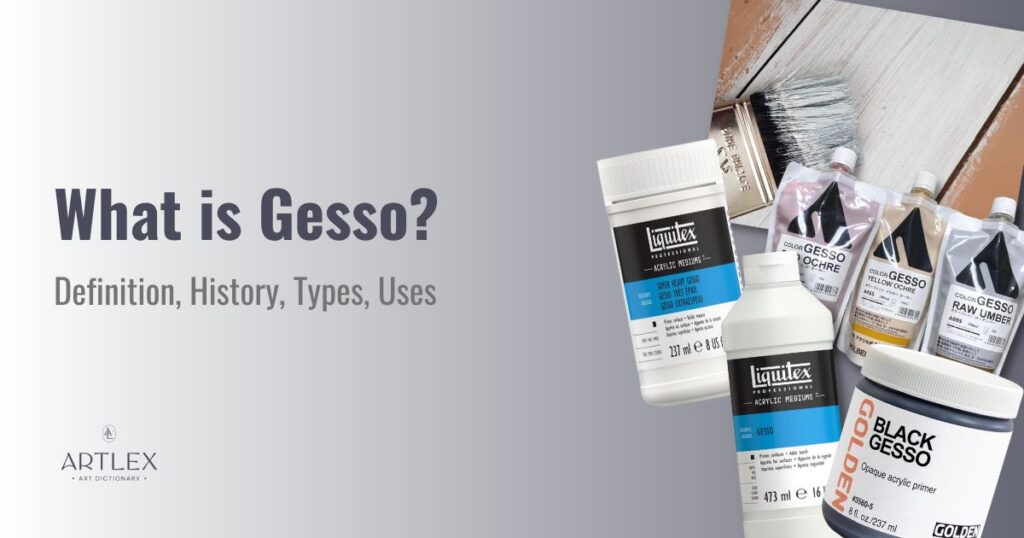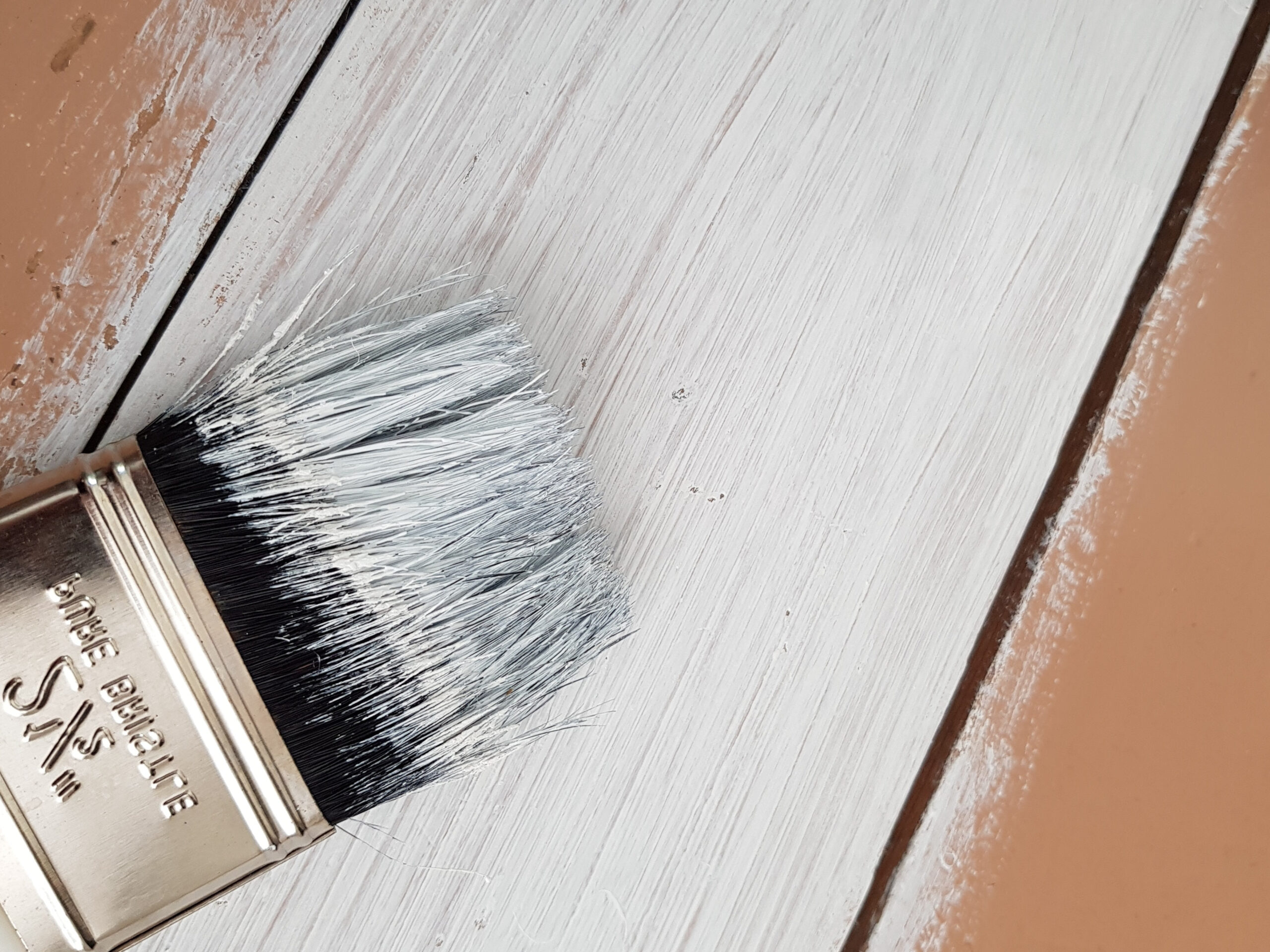 You might have heard the term gesso if you love art or want to try working with new art materials. But what exactly is “Gesso”, and why should you use it? This article aims to help those just getting started in art get to grips with this versatile medium.
You might have heard the term gesso if you love art or want to try working with new art materials. But what exactly is “Gesso”, and why should you use it? This article aims to help those just getting started in art get to grips with this versatile medium.
Gesso is an Italian word meaning “chalk” or “plaster of Paris”, and its use dates back centuries. Often referred to as simply “gesso” today, it is most often used as an underpainting primer used for preparation before painting on canvas or other surfaces; it’s made from different materials, including white pigment, chalk or gypsum powder, animal glue (or any other binding agent).
There are several types of gesso that can be used with different materials (wooden panels versus paper/cloth/canvas) and techniques. Each type has unique properties that make them best suited for certain tasks. In addition, there are various brands available on the market that offer varying degrees of absorbency and hardness, so choosing the right one can be tricky!
In this article, we’ll explore the history of gesso as well as discuss the various types that exist, their uses, and how to apply them correctly – along with tips on how to work with them effectively – plus look at some of their key benefits.
Definition of Gesso
Gesso is a white, plaster-based substance used to prepare or “prime” surfaces for painting.
The purpose of modern gesso is the same as traditional gesso: to provide a smooth, primed surface for painting. Modern gesso is usually made of a mixture of Calcium Carbonate, a binder (like acrylic polymer emulsion), and pigment (to create a white, opaque, or colored surface). The ingredients are mixed with water to create a smooth and spreadable consistency that can be easily applied to various surfaces, including canvas, wood, paper, and more.
This creates an ideal base for artists to work on, providing them with a smooth (or textured) surface that allows their brushstrokes and colors to stand out more clearly than they would on untreated canvas or wood and save on paints since you won’t need as many layers to cover the canvas surface. Gesso also helps protect the underlying material from damage caused by water and oil-based paints and the solvents used with them, which could otherwise cause cracking, damage the canvas, cause discoloration, and other forms of deterioration over time.
Beginner artists might e tempted to start working right away on the non-prepped surface and skip the (sometimes) “strenuous and time-consuming” process of prepping the canvas with gesso.
Applying gesso can get as hard as the size of your canvas and the technique you’re going to use, but if you’re a beginner, then one or two layers applied with a cheap brush will be more than enough.
History of Gesso
Gesso has a long and rich history, it’s been present throughout most of our past, and its use can be traced back to ancient times, when it was used by the Greeks and Romans to prime and smooth their painting surfaces, including marble and frescoes. During the Renaissance, gesso was extensively used to create illuminated manuscripts, panel paintings, and even for sculpting. The composition of gesso has evolved over time, as well as the materials used to make it, especially with the use of chalk and titanium dioxide in the 19th and 20th centuries, respectively, and the addition of polymeric binders and other pigments.
Types of Gesso
There are several types of gesso nowadays; however, we can group them all into two main categories that will affect the quality and durability of your work and your budget, and those are Student-grade Gesso and Artist-grade Gess
Student Grade and Artist Grade Gesso
Student-grade gesso is typically more affordable and widely available than artist-grade gesso. It is formulated for basic priming needs and is suitable for students and beginners who are just starting out with their artwork. Student-grade gesso is usually made with lower-quality materials, tends to be more liquid and “runyn” and is designed to be used in a more limited capacity. As a result, it may not be as durable or provide the same level of surface quality as artist-grade gesso.
Artist-grade gesso, on the other hand, is made with higher-quality materials and designed to meet professional artists’ needs. It is more expensive than student-grade gesso, but it provides a superior base for painting and drawing. Artist-grade gesso is made to provide a smoother and more consistent surface; it’s thicker than normal gesso allowing you to control the consistency by adding water. It also holds texture better in case that’s what you’re going for, with better adhesion and a more uniform appearance. Additionally, artist-grade gesso is often more flexible and durable than student-grade gesso, making it better suited for frequent use and for artworks that will be on display for a long time.

Black Gesso
While traditional gesso is white, now you can find black gesso as well, which is useful for paintings with an opaque, black background and to help intensify pigments and create contrast with lighter shades.
Colored Gesso
Similar to black gesso, various colored gessos are now available to help you cover larger areas, set a base for metallic pigments, or create gradients more efficiently.
Clear Gesso
Another modern form of gesso useful for diverse artistic applications is clear gesso (also known as transparent gesso). Clear gesso is helpful if an artist wants the underlying medium to show through (such as the rough surface of the canvas). Clear gesso is also used on mediums like paper, wood, and walls.
Heavy Gesso
This gesso is made specifically for heavily textured techniques, 3D effects, and thick applications with a knife or a textured brush. Perfect for impasto techniques since it holds its shape even after drying.
Note on Pre-Primed Canvases
It’s important to note that many pre-stretched canvases are often pre-primed with gesso. Keep this in mind when purchasing canvases or gesso, as you might not need to add too many layers, but note that even pre-primed canvas needs additional prepping, and you mustn’t skip this step.
Uses of Gesso
While the primary use of gesso is to prime surfaces before painting, it also has some additional utilities for artists; see below for more info:
Priming Painting Surfaces
When preparing a canvas or substrate for painting, gesso provides a “tooth,” which helps the paint adhere better to the surface.
Correcting Painting Mistakes
Because gesso acts as the ‘background’ of a painting, if there is a mistake that needs to be corrected, some artists may apply a small amount of gesso to a specific area of the painting and re-paint it.
Gesso as a Paint Lightener
Some artists prefer to use gesso instead of white paint to lighten the shade of paint. Artists have reported that they prefer the matte finish that gesso provides as opposed to a glossier finish that white paint might provide.
How To Apply Gesso

Applying gesso is an important step in creating a beautiful painting. Gesso can be applied with a paint roller, paintbrush, or paint sprayer and should be applied in thin, even coats. It is best to use a well-ventilated area when applying the gesso as it may create fumes.

When using a brush or roller to apply the gesso, make sure you use smooth strokes and cover all areas evenly. If needed, the gesso can be thinned with water for a more straightforward application process. Once the first coat of gesso has been applied, it should be allowed to dry completely before adding additional coats. This will help ensure that your painting surface is properly prepared for painting on top of it later on down the line.

Once all of your desired layers of gesso have been added and allowed to dry completely, it’s helpful to use fine-grit sandpaper to even the surface of your canvas if you want a smooth surface to paint on, on the other side; if you prefer having texture, then you can also use a textured brush, stencils or a textured roller to achieve the desired outcome before the gesso dries.

Benefits of Using Gesso
Gesso is an essential part of the painting process, as it provides a number of benefits to both the artist and their work. Gesso acts as a primer for surfaces, allowing paint and mediums to be applied without soaking into the fibers or causing long-term damage. It also adds strength to paper and journal pages, preventing paint from seeping through. Additionally, gesso can add texture to a surface that will show through if not sanded down.
Tooth and Absorbency
One of the most important benefits of using gesso is its ability to give tooth and absorbency to a painting surface. This allows acrylic paint in particular, to adhere better than it would on other surfaces such as un-primed canvas or wood. The added texture helps create interesting effects when combined with different types of paints or mediums used in artwork creation. Without gesso, acrylic paint would simply soak into the weave of canvas instead of adhering properly, which could ruin any artwork and make the paints impossible to work with.
Adds Strength to Paper
For mediums such as paper, adding a layer of gesso can increase the strength of the page and avoid damage from sharp objects, like paint knives and marker tips or oversaturation.
Adds Texture to Surfaces
While best practice dictates that gesso should be sanded down to make a smooth surface, an artist can skip this step and leave a textured surface on which to paint.
Tips for Working With Gesso
When working with gesso, it is important to have the right tools for the job. A foam brush is ideal for large surfaces, and a variety of brushes should be kept on hand. Gesso can be used on paper, art journals, canvas, fabrics, and more to create texture. It is also a must-have for many craft projects.
Before applying gesso to any surface, it’s important that you prepare the surface properly so that your project will turn out to look its best. This includes cleaning off any dust or dirt from the surface before beginning work with gesso. If you are using fabric as your base material, pre-washing it may help ensure better adhesion of the gesso when applied later in your project.
Gesso can also be used in combination with other materials, such as paint, salt, pigments, beads, or ink, depending upon what type of effect you want to achieve within your project.
Never use your good brushes with gesso, as this is a harsh material that will damage them. It’s better to get a foam roller, a cheap synthetic brush, or old brushes you don’t mind ruining.
